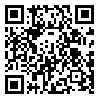Volume 1, Issue 1 (March 2019)
IEEPJ 2019, 1(1): 8-14 |
Back to browse issues page
Download citation:
BibTeX | RIS | EndNote | Medlars | ProCite | Reference Manager | RefWorks
Send citation to:



BibTeX | RIS | EndNote | Medlars | ProCite | Reference Manager | RefWorks
Send citation to:
Ebrahimi Ghavam S, Khezri H. (2019). The Role of School Connectedness and Family Cohesion in Predicting Bullying and Victimization in an Iranian Sample. IEEPJ. 1(1), 8-14. doi:10.29252/IEEPJ.1.1.8
URL: http://ieepj.hormozgan.ac.ir/article-1-23-en.html
URL: http://ieepj.hormozgan.ac.ir/article-1-23-en.html
1- Iran Allameh Tabatabaei University
Abstract: (9662 Views)
The aim of this research was to predicting bullying and victimization in school students (boys & girls) in Shiraz, in accordance to the school connectedness and the family cohesion. For this purpose, 564 students from middle schools were selected by cluster random sampling and they completed Illinois Bullying Scale, Family Adaptability and Cohesion Evaluation Scale (FACES II), and Student Perceptions of School Connectedness scale. Analysis was performed using SPSS16 software showed that the school connectedness with the standard beta coefficient -0.372, t= - 9.28 at the 99% confidence level (p<0.01) and family cohesion, with standardized beta coefficient -0.184, t= - 4.59 at the 99% confidence level (p<0.01) predicted 22% of the variance of bullying. Also, was found that the school connectedness with the standard beta coefficient -0.310, t=- 7.313 at the 99% confidence level (p<0.01) and family cohesion, with standardized beta coefficient -0.090, t= - 2.115 at the 99% confidence level (p<0.01) predicted 13% of the variance of victimization. In general, findings indicate that the weakness of family cohesion and school connectedness can be fertile ground for violent behavior at school (bullying and being victimized) by the students.
Type of Study: Original |
Subject:
Educational Psychology
Received: 2019/04/8 | Accepted: 2019/04/8 | Published: 2019/04/8
Received: 2019/04/8 | Accepted: 2019/04/8 | Published: 2019/04/8
References
1. Backus, A. S. (2010). The relationship between bullying behaviors and perceived school connectedness among middle school students. Kent State University.
2. Benitez Muñoz, J. L., & Justicia Justicia, F. (2006). Bullying: description and analysis of the phenomenon.
3. Catalano, R. F., Oesterle, S., Fleming, C. B., & Hawkins, J. D. (2004). The importance of bonding to school for healthy development: Findings from the Social Development Research Group. Journal of school health, 74(7), 252-261. [DOI:10.1111/j.1746-1561.2004.tb08281.x] [PMID]
4. Espelage, D. L., & Holt, M. K. (2001). Bullying and victimization during early adolescence: Peer influences and psychosocial correlates. Journal of Emotional Abuse, 2(2-3), 123-142. [DOI:10.1300/J135v02n02_08]
5. Espelage, D. L., & Swearer, S. M. (2003). Research on school bullying and victimization: What have we learned and where do we go from here? School psychology review, 32(3), 365-384.
6. Green, R. J., & Werner, P. D. (1996). Intrusiveness and closeness‐caregiving: Rethinking the concept of family "enmeshment". Family process, 35(2), 115-136. [DOI:10.1111/j.1545-5300.1996.00115.x] [PMID]
7. Jenkins, P. H. (1997). School delinquency and the school social bond. Journal of research in crime and delinquency, 34(3), 337-367. [DOI:10.1177/0022427897034003003]
8. Laufer, A., & Harel, Y. (2003). The role of family, peers and school perceptions in predicting involvement in youth violence. International journal of adolescent medicine and health, 15(3), 235-244. [DOI:10.1515/IJAMH.2003.15.3.235] [PMID]
9. Libbey, H. P. (2004). Measuring student relationships to school: Attachment, bonding, connectedness, and engagement. Journal of school health, 74(7), 274-283. [DOI:10.1111/j.1746-1561.2004.tb08284.x] [PMID]
10. Moos, R. H. (2003). Social contexts: Transcending their power and their fragility. American journal of community psychology, 31(1-2), 1-13. [DOI:10.1023/A:1023041101850]
11. Murray-Harvey, R., & Slee, P. T. (2010). School and home relationships and their impact on school bullying. School Psychology International, 31(3), 271-295. [DOI:10.1177/0143034310366206]
12. Olson, D. H., Bell, R., & Portner, J. (1992). Family inventories manual. Minneapolis, MN: Life Innovations.
13. Piotrowski, D., & Hoot, J. (2008). Bullying and violence in schools: What teachers should know and do. Childhood Education, 84(6), 357-363. [DOI:10.1080/00094056.2008.10523043]
14. Springer, A. E., McQueen, A., Quintanilla, G., Arrivillaga, M., & Ross, M. W. (2009). Reliability and validity of the Student Perceptions of School Cohesion Scale in a sample of Salvadoran secondary school students. BMC international health and human rights, 9(1), 30. [DOI:10.1186/1472-698X-9-30] [PMID] [PMCID]
15. Sprott, J. B., Jenkins, J. M., & Doob, A. N. (2005). The importance of school: Protecting at-risk youth from early offending. Youth Violence and Juvenile Justice, 3(1), 59-77. [DOI:10.1177/1541204004270943]
16. Stewart, E. B. (2008). School structural characteristics, student effort, peer associations, and parental involvement: The influence of school-and individual-level factors on academic achievement. Education and urban society, 40(2), 179-204. [DOI:10.1177/0013124507304167]
17. Swearer, S. M., & Doll, B. (2001). Bullying in schools: An ecological framework. Journal of Emotional Abuse, 2(2-3), 7-23. [DOI:10.1300/J135v02n02_02]
18. Swearer, S. M., Espelage, D. L., Vaillancourt, T., & Hymel, S. (2010). What can be done about school bullying? Linking research to educational practice. Educational researcher, 39(1), 38-47. [DOI:10.3102/0013189X09357622]
19. Wienke Totura, C. M., MacKinnon-Lewis, C., Gesten, E. L., Gadd, R., Divine, K. P., Dunham, S., & Kamboukos, D. (2009). Bullying and victimization among boys and girls in middle school: The influence of perceived family and school contexts. The Journal of Early Adolescence, 29(4), 571-609. [DOI:10.1177/0272431608324190]
20. Wilson, D. (2004). The interface of school climate and school connectedness and relationships with aggression and victimization. Journal of school health, 74(7), 293-299. [DOI:10.1111/j.1746-1561.2004.tb08286.x] [PMID]
| Rights and permissions | |
 |
This work is licensed under a Creative Commons Attribution-NonCommercial 4.0 International License. |







